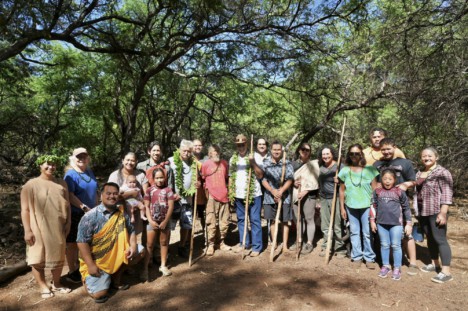New Reforestation Effort Begins at ʻAikoʻolua in Kamalō

Ka Ipu Makani Cultural Heritage Center launched a 12-acre reforestation project at Kamalō in November. Contributed photo
Ka Ipu Makani News Release
Ka Ipu Makani Cultural Heritage Center has officially launched the Kīpuka Kamalō Reforestation Project, a community-led effort to reforest 12 acres of ʻāina at ʻAikoʻolua within the Kamalō Ahupuaʻa. The project seeks to restore ecological and cultural health to one of East Molokaʻi’s most degraded landscapes, addressing soil erosion and sedimentation that have long impacted nearshore fisheries and reefs.
A Hoʻolaʻa ʻĀina (land dedication and blessing ceremony) was held in early November, bringing together an intimate group of partners, as well as kupuna and descendants of Kamalō. The blessing was conducted by Kahu Jimmy Duvauchelle, who offered pule and words of guidance as participants came together to honor the ʻāina and set intentions for the restoration work ahead. The ceremony marked the first step toward healing the land and protecting one of the last remaining wiliwili (Erythrina sandwicensis) groves of East Molokai.
Led by Ka Ipu Makani Cultural Heritage Center, in partnership with Bobby Alcain of ʻĀina Pulapula, the Kīpuka Kamalō Restoration Project will focus on reestablishing native dryland forest species and improving watershed health to reduce sediment runoff into the ocean. Over time, the project will serve as a living demonstration of community-based stewardship — uniting cultural knowledge, restoration science, and hands-on learning for youth and ʻohana across the island.
“This effort represents not only the healing of the land, but the healing of our relationships with it,” project lead Bobby Alcain said. “Through collective care, we can ensure that Kamalō’s wiliwili and native forest communities continue to thrive for future generations,” added Dr. Pūlama Lima, Executive Director of Ka Ipu Makani.
Work at the ʻAikoʻolua site will continue through 2026, with planned activities including invasive species removal, native seed propagation, outplanting, and long-term ecological monitoring. Community volunteer days and education programs will be announced in early 2026 as the project enters its planting phase.
Mahalo to the Maui County Department of ʻŌiwi Resources and the First Nations Development Institute for their support in making this project possible.
For more information about Ka Ipu Makani Cultural Heritage Center and the Kīpuka Kamalō Project, visit www.kaipumakanichc.org or follow @kaipumakani on social media.











Don't have a Molokai Dispatch ID?
Sign up is easy. Sign up now
You must login to post a comment.
Lost Password